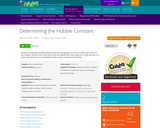
In this lesson, students graph the recessional velocities and distances of galaxies to determine the Hubble constant.
- Subject:
- Astronomy
- Earth and Space Science
- Material Type:
- Activity/Lab
- Author:
- CPalms
- Date Added:
- 02/11/2019

In this lesson, students graph the recessional velocities and distances of galaxies to determine the Hubble constant.
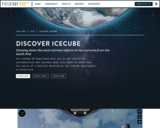
The IceCube VR experience puts you in the role of an astrophysicist who journeys deep into space to track down the source of a neutrino detected by the IceCube observatory in Antarctica. At the research station at the South Pole, you will see the large instrument, buried in the ice, detect a mesage from across the universe. Using your “impossibility drive,” you will follow the neutrinos path back to the black hole it was emitted from. Along the way, you will be able to take in awe inspiring views from the edge of the solar system, looking back from the milky way and dangerously close to a black hole. You will be able to see using not only your normal visible spectrum, but also using X-ray vision and neutrino vision, revealing entirely different views of space.
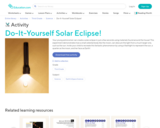
Recreate the fantastic phenomena of solar eclipses with your child using just a flashlight, a quarter, and her very own face!
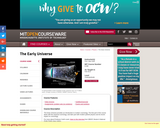
The Early Universe provides an introduction to modern cosmology. The first part of the course deals with the classical cosmology, and later part with modern particle physics and its recent impact on cosmology.

The purpose of this activity is to recreate the classic egg-drop experiment with an analogy to the Mars rover landing. The concept of terminal velocity will be introduced, and students will perform several velocity calculations. Also, students will have to design and build their lander within a pre-determined budget to help reinforce a real-world design scenario.

A learning activity for the Scoop on Soils book in the Elementary GLOBE Series. Each student will make predictions about the properties of various soil samples. Then they will examine several types of soils and record their observations. Next, they will learn about soil profiles and horizons by both examining a soil sample in a jar and by creating a soil profile flip chart. The purpose of the activity is to provide the opportunity for students to ask questions and make observations about soil and introduce students to the properties of soil and to the concept of soil profiles and horizons. After completing this activity, students will know about soil's different properties and about soil profiles. Students will know that soils have different properties including texture, color, and size. They will know that soil forms layers based on these properties.

Students will learn about magnification and how a magnifying lens works. They will examine a variety of different objects, first without a magnifier and then with a magnifier, and compare what they observe. They will practice observing details of these objects with magnifying lens. The purpose of this activity is for students to learn about observation skills and how tools can help people make observations, what "magnification" means, and to learn that scientists use tools, such as magnifying lenses, to examine objects. Students will be able to identify a magnifying glass and its purposes. They will be able to describe how the same object looks different when using the unaided eye versus a magnifying lens.

A learning activity for the Scoop on Soils book in the Elementary GLOBE Series. Students will make predictions about what they think they will find in a sample of soil. They will investigate the sample and sort out the various items they find. Next they will spend time outside observing one or more sites to see what they find in the soil. After recording and sharing their observations they will create their own stories about the things they found in the soil. The purpose of the activity is to learn about natural things commonly found in soil and how these things impact how the soil looks and feels as well as to introduce students to the concept of decomposition. After completing this activity, students will know about various things found in soil including rocks, critters, roots, and other organic material. They will also understand that animals and microorganisms aid in the decomposition process that contributes organic materials to soils.

A learning activity for the "Do You Know That Clouds Have Names?" book in the Elementary GLOBE series. Students will explore the difference between the three types of contrails, make observations of contrails outside, and record their observations. Fifteen minutes later they will make follow-up observations to see how the contrails they observed have changed. The purpose of the activity is to help students identify contrails and learn to distinguish between the three types of contrails and to understand that contrails are human-made and some contrails become clouds in the sky. Students will be able to (1) identify the three types of contrails; (2) understand that contrails are created by jet airplanes; and (3) understand that some contrails become clouds.
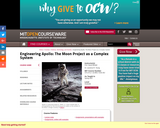
This course is a detailed technical and historical exploration of the Apollo project to "fly humans to the moon and return them safely to earth" as an example of a complex engineering system. Emphasis is on how the systems worked, the technical and social processes that produced them, mission operations, and historical significance. Guest lectures are featured by MIT-affiliated engineers who contributed to and participated in the Apollo missions. Students work in teams on a final project analyzing an aspect of the historical project to articulate and synthesize ideas in engineering systems.
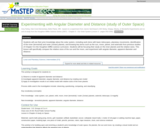
This is an activity on apparent sizes and apparent angles, related to understanding how distance affects what we observe in outer space (the sun, moon, stars, or planets).
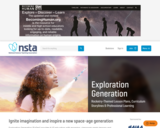
Site with engaging and classroom-ready lessons. Good for K-12! Gets students introduced to aerospace, engineering, and rocketry.

This guided inquiry activity has students using models to create variations of alignment of the Earth, Moon, and Sun. By varying their arrangement, students will discover how the positions of the Earth, Moon and Sun interact, how shadows can be cast on the Moon and on the Earth, and how Earth's view of the lit portion of the Moon changes.

This lesson can be taught for first grade during the unit on patterns in space.This lesson can be added to Amplify’s Spinning Earth: Investigating Patterns in the Sky unit. It can be used with Lesson 2.1 after watching Zoom Out to Space videosChapter 2 Driving Question: Why was it daytime for Sai when it was nighttime for his grandma?The pursuit of Identity can be addressed throughout this unit. It is defined by Gholdy Muhammad as "Who you are, who others say you are and who you desire to be". Students see that a woman and person of color was able to fulfill her dreams of becoming an astronaut despite having this dream dismissed by a teacher. She took her parents' advice. She dreamt of being an astronaut, she believed she could do it, and she worked hard to achieve this goal.
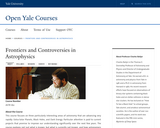
This course focuses on three particularly interesting areas of astronomy that are advancing very rapidly: Extra-Solar Planets, Black Holes, and Dark Energy. Particular attention is paid to current projects that promise to improve our understanding significantly over the next few years. The course explores not just what is known, but what is currently not known, and how astronomers are going about trying to find out.

Roughly one hundred billion galaxies are scattered throughout our observable Universe, each a glorious system that might contain billions of stars. Many are remarkably beautiful, and the aim of Galaxy Zoo is to study them, assisting astronomers in attempting to understand how the galaxies we see around us formed, and what their stories can tell us about the past, present and future of our Universe as a whole. Are you an educator? Would you like to use Galaxy Zoo with a group of students? The Navigator is an interactive tool that allows groups to classify galaxies together and then investigate galaxy characteristics. Zoo Teach is where educators can share lessons, resources and that compliment the citizen science projects that are part of the Zooniverse.
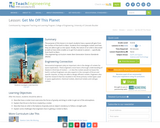
The purpose of this lesson is to teach the students about how a spacecraft gets from the surface of the Earth to Mars. The lesson first investigates rockets and how they are able to get us into space. Finally, the nature of an orbit is discussed as well as how orbits enable us to get from planet to planet specifically from Earth to Mars.
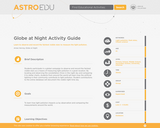
Students participate in a global campaign to observe and record the faintest visible stars as a means of measuring light pollution in a given location. By locating and observing the constellation Orion in the night sky and comparing it to stellar charts, students from around the world will learn how the artificial lighting in their community contribute to light pollution. Student contributions to the online database will document the visible night time sky.

This activity is an investigation of the Earths Moon phases and its position in the sky.
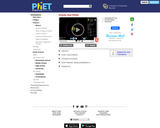
Move the sun, earth, moon and space station to see how it affects their gravitational forces and orbital paths. Visualize the sizes and distances between different heavenly bodies, and turn off gravity to see what would happen without it!